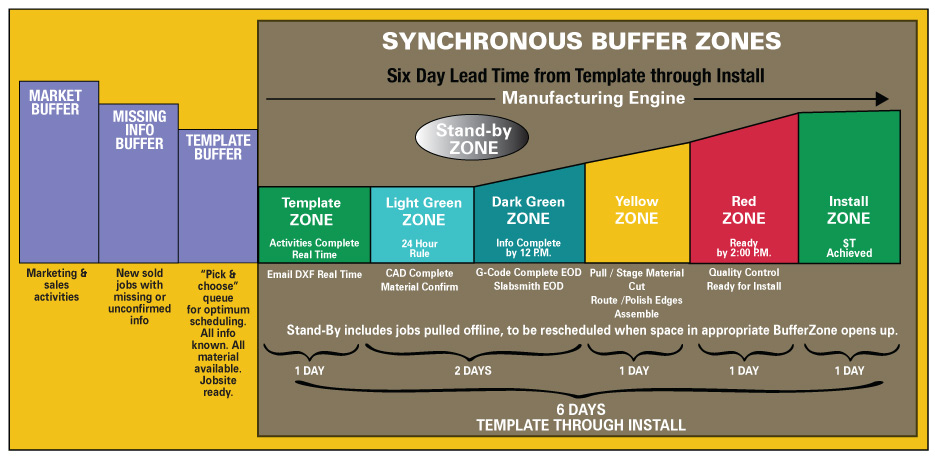Velocity
Ed Hill
Synchronous Solutions
Velocity is all about selling speed. It is about being the fastest and the most reliable in your market. The Synchronous Flow system is designed to achieve a one-week cycle time from Template through Install. Template on Monday and Install the next Monday. This is a systematic approach that assures the quoted cycle time; even shorter than one week if you need it.
Ask your salespeople: “If we could guarantee a one-week cycle time from Template through Install, could you sell more?”
As a manufacturer, you do basically three things:
You provide a quality product. This is not a competitive opportunity. It is an essential element of your business. The quality of the finished product must be excellent. It is no longer valid to say that your quality is better than your competition. Everyone’s quality must be excellent, or you will not be allowed to exist in the market.
You must provide reasonable pricing. This is not a competitive opportunity. The pricing of your products must be sensible, but in a custom manufacturing market it is not much of a competitive opportunity either. It you compete on pricing; you will become a commodity. Someone can always make it a bit cheaper. It is much better to maintain a reputation for excellent quality at reasonable pricing than to compete on pricing alone. Moreover, in many cases, the price of your product is dictated by your customers, so you have little opportunity to negotiate.
You must provide excellent customer service. This IS a competitive opportunity, and you can sell velocity. Time, speed, reliability. Most companies can produce a good quality product at a reasonable price. The best companies are those that can do all that plus do so faster and with more reliability than their competitors. Speed to market, while maintaining excellent quality and reasonable pricing, should be the focus of the successful manufacturer today. In fact, with excellent quality and reliability quick process times you have much more clout to quote your own prices.
The Synchronous Flow system provides a process to achieve short cycle times with excellent reliability. It is all a matter of how much water is in the river.
Imagine a mountain stream. You are in a canoe, just floating along. If the water is deep your canoe will be moving slowly like the flow of the water.

Now imagine the same mountain stream in an area of shallow water. Now you are on white water, and the canoe will be moving rapidly like the flow of the water.
If you have lots of inventory between Template and Install, your cycle times will be longer. If you carefully control the amount of inventory, you can control your cycle times. If you have one week of inventory, measured in Throughput ($T) dollars, you will have a one-week cycle time. The way to do that is to lower the inventory levels to equal the number of days for your desired cycle time and then assure that you allow entry of $T into the system at Template only at the same rate as exit at Install in $T value. This is actually easier to accomplish than it may seem. We have developed the system to accomplish it with reliability. The Synchronous Flow system can help you achieve and maintain rapid cycle times.
Now, back to the mountain steam. As you were floating along on the deep water, there were boulders and obstacles below the water surface. They were not a problem to your canoe because they were at the bottom of the deep water. Downstream, in the shallow whitewater section, those boulders and obstacles would be exposed. Now they are a problem to your canoe.

The real world of your fabrication plant is much the same. Those boulders come in the form of absent workers, machine downtime, poor quality materials, incorrect or incomplete customer information and myriad other issues that custom manufacturers face. Adding more inventory (raising the water level) is not a good solution because that extends your cycle times. So, you need a system to deal with these issues.
The Process Time (aka cycle time between Template and Install) is the velocity you can control within your business. It begins when you have confidence of three essential elements for any manufacturer. You will need assurance of these three things before you release new jobs into your system:
1) All information known. All means all. You can’t possibly produce a finished product without knowledge of exactly what the customer wants. It is foolish to enter a job into your system when any piece of information is unknown. This is one of the most important disciplines of the successful manufacturer. It is the responsibility of the Sales and/or Project Management staff to secure this information before a job is released to manufacturing.
2) All material available. Again, all means all. Either the material should be on site or there should be some confidence that the necessary quantity will arrive before the first manufacturing step. Any delay in a manufacturing step will lengthen the Process Time.
3) Jobsite ready. This means that someone (probably Project Management) has spoken with the Customer to confirm that all preparatory steps will have been completed before the arrival of your Team for Templating and Installation. This would include items such as cabinet installation, other trades out of the way, easy access to the jobsite, etc.

In custom manufacturing it is reasonable to maintain some accommodation for “Murphy” (aka: stuff happens). In making widgets, like automotive parts or printing, engineers work to eliminate variability. In custom manufacturing, we accept the inevitability of some variation (Murphy) and we set the system to deal with it. The two things you can and should do to accommodate Murphy are maintaining some Protective Capacity and some levels of strategically placed inventory “Buffers” between selected operational steps. Both of these strategies are essential in the custom manufacturing world.
Protective Capacity is the extra capacity beyond the minimum to produce the demand. It is the accommodation for Murphy. If you plan your system to only meet the basic demand, you rarely will achieve that objective. Because “Murphy Lives.” Stuff happens. The smart manufacturer is the one who plans for this inevitability with strategic staffing and equipment availability to overcome the unavoidable issues that occur every day in a custom world. Our Protective Capacity Planner is the tool to use in setting up this approach.
Buffer Management is the other tactic that will allow you to control the flow of information and materials throughout your system. In this approach, we divide the process flow into colored zones. Each zone in the example below represents one day of cycle time. Using this system, we can know exactly where a job should be today relative to the day in the future that it is planned to be installed. Therefore, we can proactively manage the flow of all jobs. We can take action early in the process to assure jobs will be ready for the day of installation while avoiding those last-minute rushes to get a job ready. As a result, the level of chaos can be dramatically reduced.
Ultimately, Inventory equals time. In any manufacturing system, the amount of orders within your system determines your cycle times. If you limit inventory to one week between Templating and Installation, you have a one-week process time.
Beyond excellent quality and reasonable pricing, your competitive opportunities are all about speed and reliability. Synchronous Flow is designed to help you do that.
For more information on how to maintain a rapid and reliable process time, contact Ed Hill, Synchronous Solutions, 704-560-1536
Visit www.SynchronousSolutions.com .